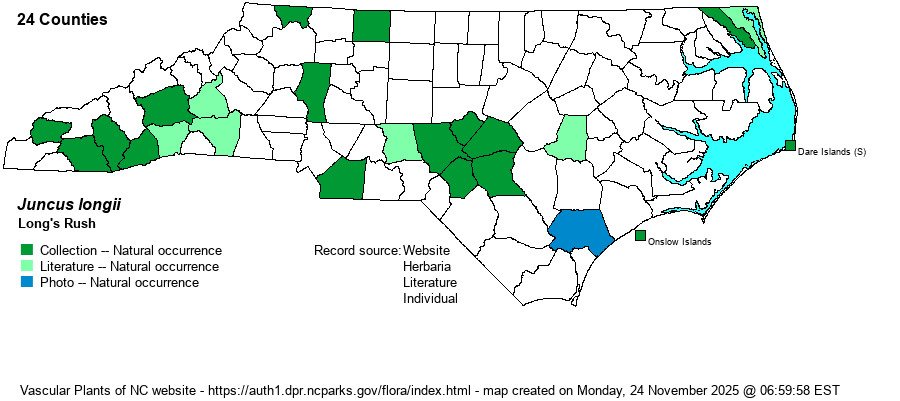| Section 5 » Order Juncales » Family Juncaceae |
Show/Hide Synonym
| taxonName | relationship | relatedTaxonName | relatedTaxonRefText | relComments |
|---|
|
|
|
|
|
|
| Juncus longii | < | Juncus biflorus | Gleason and Cronquist (1991) | | | Juncus longii | < | Juncus biflorus | Gleason (1952) | | | Juncus longii | < | Juncus marginatus | Flora of North America (1993b, 1997, 2000, 2002a, 2002b, 2003a, 2004b, 2005, 2006a, 2006b, 2006c, 2007a, 2009, 2010) | | | Juncus longii | < | Juncus marginatus | Godfrey and Wooten (1979, 1981) | | | Juncus longii | < | Juncus marginatus | Wunderlin & Hansen Flora of Florida (3) | | | Juncus longii | < | Juncus marginatus | | (also see J. biflorus and J. longii) | | Juncus longii | = | Juncus aristulatus var. aristulatus | Small (1933, 1938) | | | Source: Weakley's Flora |
|
| Author | Fernald | |
| Distribution | Scattered locations across the state, with concentrations in the Sandhills and southern Mountains. However, most of the VA records are for the inner Coastal Plain, and thus the seeming absence in northeastern NC is odd and may be due to being overlooked. Gaps will likely be filled in as botanists learn this species.
MD to TN, south to GA and LA. | |
| Abundance | Scattered on the landscape, often with large gaps between populations. Generally uncommon, at least in the southern Mountains and the Sandhills; seemingly very rare elsewhere. The website editors choose to give a State Rank of S3 (as there are reports for 22 counties). | |
| Habitat | Wet, often mucky or clayey, soils of blackwater streamheads, small stream swamps, montane seepages and meadows, interdune marshes, fresh marshes, roadside ditches. Has a preference for open or semi-open conditions and soft wet soils -- i.e., "boggy" or "mucky" places. | |
| Phenology | Flowering and fruiting June-September. | |
| Identification | Long's Rush is very like Bog Rush (J. biflorus) in height and in having flat leaf blades, has a more compact inflorescence (often densely so), and has narrower, much longer, horizontal rhizomes. From Grassleaf Rush (J. marginatus) it is taller, has wider leaves, and fewer flowers per head. See Knapp and Naczi (2008) for details of this often-overlooked species and its close relatives. | |
| Taxonomic Comments | For decades it was lumped into J. marginatus, and FNA continues to do so.
NOTE on Juncus: These "grasslike" or "sedgelike" plants occur in most habitats, especially where moist or wet. They can immediately be told from grasses and sedges by the presence of 6 tepals (petal-like) that surround the fruit. These tepals can be thought of as analogous to sepals and petals of, say, lilies or trilliums. Most species have brown, chestnut, or reddish tepals and dark brown fruits. The flowers occur in few- to many-flowered heads. Leaves are nearly all basal and round in cross-section. Stems are unbranched, except for the inflorescence. Fruits are termed capsules and contain many tiny seeds. | |
| Other Common Name(s) | None | |
| State Rank | S1S2 [S3] | |
| Global Rank | G3Q | |
| State Status | W7 [W1] | |
| US Status | | |
| USACE-agcp | OBL link |
| USACE-emp | OBL link |

